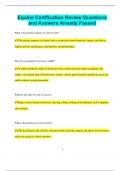Equine Certification Review Questions
and Answers Already Passed
What is the primary purpose of a horse's diet?
✔✔The primary purpose of a horse's diet is to provide essential nutrients, energy, and fiber to
support growth, maintenance, reproduction, and performance.
How do you properly fit a horse's saddle?
✔✔A saddle should fit snugly on the horse's back, with no pressure points or gapping. The
saddle’s tree should align with the horse's withers, and the girth should be adjusted to secure the
saddle without causing discomfort.
What are the signs of colic in a horse?
✔✔Signs of colic include restlessness, pawing, rolling, looking at the abdomen, lack of appetite,
and sweating.
What is the function of a horse's hoof?
✔✔The hoof protects the sensitive structures inside, provides support, and allows for movement,
while also acting as a shock absorber.
1
,How often should a horse’s hooves be trimmed?
✔✔A horse’s hooves should typically be trimmed every 6 to 8 weeks to prevent overgrowth and
maintain balance.
What are the signs of lameness in a horse?
✔✔Signs of lameness include limping, uneven gait, reluctance to bear weight on one limb, or
visible swelling in the legs or joints.
What is the most common type of horse vaccination?
✔✔Core vaccinations include tetanus, West Nile virus, and Eastern/Western equine
encephalomyelitis.
How do you properly groom a horse?
✔✔Grooming involves brushing the horse to remove dirt and debris, checking for injuries, and
maintaining coat and skin health by using a curry comb, dandy brush, and body brush.
What is the purpose of the bit in a horse's bridle?
✔✔The bit is used to communicate with the horse through the reins, providing signals for
direction, speed, and control.
2
,What are the signs of dehydration in a horse?
✔✔Signs of dehydration in a horse include sunken eyes, dry gums, thickened saliva, and skin
that doesn’t snap back when pinched.
How do you monitor a horse's vital signs?
✔✔Monitor a horse’s vital signs by checking the pulse rate (28-44 beats per minute), respiratory
rate (10-24 breaths per minute), and temperature (99-101°F).
What is the difference between a colt and a filly?
✔✔A colt is a young male horse, while a filly is a young female horse.
How can you tell if a horse is in heat?
✔✔Signs that a horse is in heat include frequent urination, a raised tail, restlessness, and an
interest in male horses.
What is the role of a horse's girth?
✔✔The girth secures the saddle to the horse's body, ensuring it stays in place during riding and
preventing movement.
3
, What should you check before riding a horse?
✔✔Before riding, check the horse's tack, hooves, health, and overall condition to ensure the
horse is fit and safe for riding.
What is the best way to introduce a horse to a new rider?
✔✔Introduce the horse to a new rider gradually, allowing the horse to become familiar with the
rider’s voice, movements, and handling before riding.
What are some common equine injuries?
✔✔Common equine injuries include strains, sprains, fractures, cuts, and bruises, often caused by
overexertion, falls, or improper handling.
What is the best practice for cooling down a horse after exercise?
✔✔Cool down a horse slowly by walking it for 10-15 minutes to prevent muscle stiffness and
promote circulation.
How do you recognize a horse's ideal body condition?
4




